WooCommerce vs. Shopify: a detailed comparison guide
Are you preparing for an online store? And stuck between Shopify or WooCommerce?
WooCommerce and Shopify are the biggest players in the eCommerce space. Both have considerable strengths to build the perfect store online.
You can build a successful online store using one of these platforms. It is never too late to launch an online store because global eCommerce sales reach $4.28 trillion. However, choosing between Shopify or WooCommerce isn’t easy.
But considering this guide, we tackle two leading champions: WooCommerce and Shopify. These two are excellent options to run a successful online store.
So, it’s time to figure out which comes to the top!
Have a look at how detailed comparison goes on:
Overview: WooCommerce vs. Shopify
Before we move forward to the comparison, it is vital to cover the basics of both the platforms and attributes that make WooCommerce and Shopify stand out.
What is WooCommerce?
It is an open-source platform built for WordPress. Your WooCommerce store runs on the world’s leading content management system WordPress. As it is made for WordPress, you will have infinite customization options.
According to one research, WordPress powers one-third of the websites on the web. And that’s why WooCommerce is the most popular eCommerce platform than Shopify.
You can easily add or customize custom extensions. Thus, if you own a readymade WordPress website then you’re good to go with WooCommerce. Just install WooCommerce and you are ready to launch your eCommerce store in minutes.
What is Shopify?
Shopify is a complete eCommerce solution to build an online store using its website builder.
Don’t worry about the technical aspects including payment gateway, inventories, web hosting, caching, security, etc. with Shopify.
However, the decision of choosing WooCommerce or Shopify relies on your requirements and skills.
How to choose an eCommerce platform?
While starting an online store, you have to take care of a few things in mind. These factors help you decide among the best eCommerce platforms.
Cost of ownership: The budget is the primary factor to consider for a fully functional eCommerce store.
Usability: An eCommerce platform should be easy to use for novice users.
Payment Options: It should support different payment methods including PayPal, Stripes, and other merchants.
Third-party Add-ons: Total number of third-party integrations and services that you can use to grow your online business.
Scalability: Both platforms will be able to scale your business growth.
These are the essentials of an eCommerce platform to consider. You can also look at other needs like shipping, security, taxes, inventory management, etc.
Through this article, you can learn about how WooCommerce and Shopify pursue these basic requirements.
So, without waiting much, let’s dive into WooCommerce vs. Shopify comparison.
Budget Comparison: WooCommerce vs. Shopify
Pricing is one of the most vital considerations while choosing an eCommerce platform for your business.
You first need to fix a budget by keeping in mind other costs including third-party integrations and add-ons services.
Let’s find out how WooCommerce and Shopify charge?
Cost of WooCommerce
WooCommerce is a free plugin of WordPress.
You just need a domain name and a WordPress hosting account to get started with WooCommerce.
To build a WooCommerce based online store, you need to spend a domain cost, SSL certificate cost, and web hosting costs.
If you’re planning to start an eCommerce store with WooCommerce then your expenditures are:
- WordPress Hosting: $9.99 (per month)
- Domain Name: $19.99 (yearly)
- SSL certificate: $49
- WooCommerce theme: $69 (If you choose a premium theme)
As a result, starting a WooCommerce store is not cheap. However, you can go for customized WooCommerce hosting plans that reduce the total cost.
Starting an eCommerce store with WooCommerce is costly in the beginning but it is lower than Shopify.
WooCommerce is a long-term investment for you. As it is built for WordPress, you can also have the advantage of free alternatives such as themes and plugins.
This way you can reduce the cost by installing free or premium themes and plugins when needed.
When you compare WooCommerce with Shopify, you will see that most of the users prefer WooCommerce because of cost breakdown.
WooCommerce also doesn’t charge on every purchase. You have to worry about the processing fees by third parties.
You can overcome this cost using a lot of ways by choosing bank transfer, cheque payments, and COD.
Thus, with several free themes and add-ons, WooCommerce can be the winner when it comes to the cost.
Cost of Shopify
When it comes to Shopify, it is a very easy-to-use eCommerce platform.
You can get Shopify from starting the basic plan at $29 to the advanced plan at $229 on monthly basis.
All of these plans include web hosting and an SSL certificate. But, if you want to use your business name as a domain name, then you have to purchase a domain separately which will cost approx $14 yearly.
Shopify has visibly hidden costs. The basic plan is suitable initially but when your business grows, you will require third-party tools and add-ons to take your business to the next level.
Have a look at Shopify plans below:
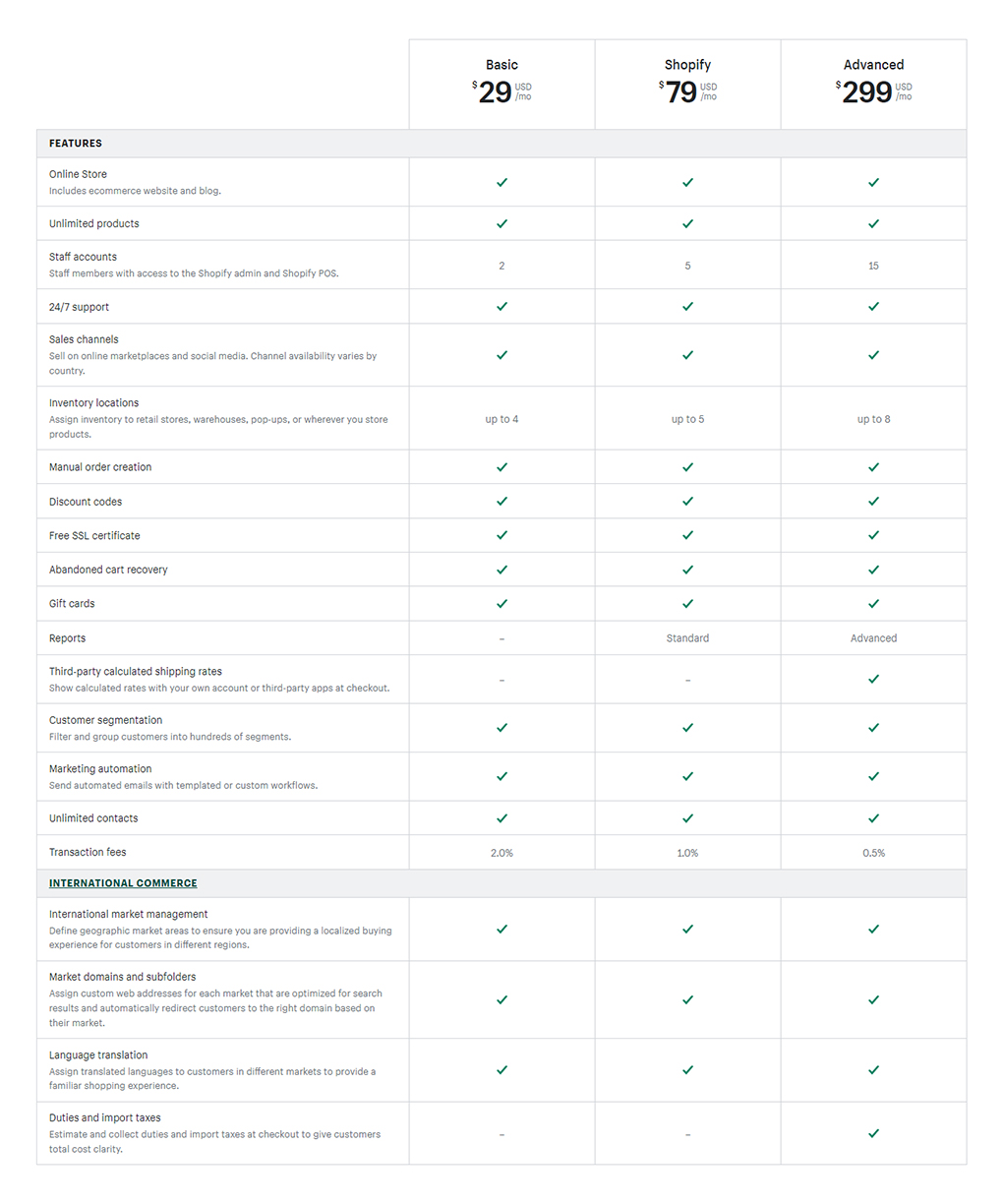
You can add unlimited products with two staff accounts and have access to 24/7 support.
When your business expands, you can upgrade your Shopify account with $79 or $299 on monthly basis.
Advanced Shopify plan gives the list of features when your business grows.
Apart from this, most of the payments are online when you have an online store. So, you have to pay the additional cost that Shopify charges 2.9% + 30¢ for each credit card sale.
The below chart will guide you more on Shopify payments.

Apart from this, if you go for other payment methods, Shopify charges 2% extra as a fee.
Other than these expenses, you will require other add-ons to make your store work seamlessly.
Most of you choose Shopify because of its reasonable price. But, when your business grows with a 100x increase in sales, the additional cost may go up. This is the only thing that you have to think about while choosing Shopify.
Thus, after all, things considered about WooCommerce and Shopify, we can say that WooCommerce is a winner in this category.
Usability Comparison: WooCommerce vs. Shopify
Most of the users are not born web designers and developers and so the usability of both platforms is essential.
However, this is the place where Shopify and WooCommerce have different features. Here, user experience depends on the level of your website. Means how advanced a site you want or how much time you are going to invest in setting up a website.
Let’s check out how WooCommerce and Shopify prove their user-friendliness.
Usability of WooCommerce
Compare with Shopify, WooCommerce is not a hosted platform and so, you have to play a complete installation process from the scratch.
From installing a WooCommerce plugin to set up a website on WordPress, managing updates and backups, you have to make sure about each detail of your website.
However, there are various free and premium plugins available that take care of these tasks.
You can customize your WooCommerce store using the infinite customization options that WordPress offers. It also gives full control of a website.
You can start running a WooCommerce-based online platform easily with the help of thousands of plugins.
As you are building a complete online marketplace from the start, you may face a lot of problems. You have to think about these factors before choosing WooCommerce.
Though, you can make live changes using different page builders of WordPress because there is no built-in page builder.
This is the biggest drawback of WooCommerce. A small change may create a negative impression if the change goes wrong.
Since it is just a plugin, WooCommerce depends on third-party add-ons like themes, plugins, hosting, and WordPress.
But with its popularity, you can take help from online groups, forums, videos, etc. to solve issues.
Usability of Shopify
You have to no worry when Shopify is with you. It is a fully hosted eCommerce platform. You just follow an introductory setup because Shopify handles every other process.
It will manage inventory, security, payment gateways, and design your store. Shopify handles your store smoothly.
You can easily set up sales and discounts using a simple drag-and-drop interface. Change the look of your store or add extra inventory. All things are friendly with Shopify.
Most of the leading stores or companies often choose Shopify because of its feature-rich user experience.
However, if we look into its downside, Shopify limits your freedom. Compare to WooCommerce you don’t have full control over the website. You can only use features and functions provided by Shopify.
But, this is not bad as it sounds because Shopify gives a wide section of themes and add-ons that will need to start an online store.
In end, there are visible differences between Shopify and WooCommerce. You can find everything available on the Shopify dashboard. And with WooCommerce, you have to search first and customize according to your preferences.
So, the winner is Shopify when usability matters.
Payment Method Comparison: WooCommerce vs. Shopify
Both the platforms have a significant amount of payment methods. You can use all payment options to accept payment. However, your customers may use a different method that you don’t use.
So, it is better to check different payment options offered by both WooCommerce and Shopify.
Payment Methods in WooCommerce
WooCommerce has in-built PayPal because it is a universal payment method. You can accept credit card payments with PayPal. You can use different options with plugins and third-party integrations.
Apart from the online payment option, you can also offer direct bank transfer or COD. Apart from these, if you have other requirements, you can install its extension easily.
Have a look at a few payment options that WooCommerce supports:
- WooCommerce Payment Gateway – PayPal
- WooCommerce Payment Gateway – Stripe
- WooCommerce Payment Gateway – Square
- WooCommerce Payment Gateway – Amazon Pay
- WooCommerce Payment Gateway – Alipay and many more.
No matter where you’re selling the products, your payments are safe with WooCommerce.
Using different payment gateways, you can offer memberships and discounts to generate more ROI.
What to choose and how to plan different campaigns – it’s up to you.
Payment Methods in Shopify
Both platforms support most of the payment methods. However, Shopify has its own payment gateway named Shopify Payments.
You can use Shopify Payments using a credit card by considering processing fees. Without following a signing process like stripe, you can use this method.
Other methods that Shopify allows:
- PayPal
- Amazon Pay
- Google Pay
- Cryptocurrency
- Apple Pay
Apart from these payment options, Shopify supports available payments of the respective country. For bank transfer or COD payment, don’t forget to choose manually.
WooCommerce and Shopify deliver flexible payment options. Most of the methods are the same but set up differently.
Thus, this category holds a tie between WooCommerce and Shopify.
Add-ons Comparison: WooCommerce vs. Shopify
You will always need third-party integrations to grow your store. Both platforms give flexible functionalities that are used in the growth of your store.
Third-party integrations and add-ons play a vital role in the future of your store. Using them, you can build your dream store the exactly you want. However, you have to shred a few dollars for premium integrations.
Let’s have a quick look at the Add-ons comparison of WooCommerce and Shopify.
WooCommerce Add-ons
You will have access to more than 50,000+ free and premium WordPress plugins with WooCommerce.
You can easily utilize these integrations to set up payment, SEO, social media integration, and lead generation.
You will find more add-ons compare to Shopify. This is all because of WordPress. You can use all plugins as per your needs without any hassle.
Installation of third-party integration is easier than Shopify. With a few clicks, your add-ons are ready to launch, while Shopify takes more than compares to WooCommerce.
Just write the name of the extension and you’re ready to customize it.

As WooCommerce is an open-source platform, you are more flexible with customization. However, for any professional need, you can always hire a WordPress developer.
Shopify Add-ons
Shopify has its own marketplace where you can buy third-party plugins for free or paid.
You will find hundreds of plugins available at the Shopify App Store.
From lead generating to SEO, Shopify covers everything that you will need to grow your business online.
Shopify makes the installation of third-party integration as easy as possible. You will have a wide variety of add-ons collections and categories.
The only drawback is that Shopify has most of the paid plugins and those are also with recurring monthly or transaction based cost. You can use their free trials but you have to pay once trials are over.
Thus, with WooCommerce, you will have always a free alternative of add-ons as compared to Shopify.
In the end, WooCommerce wins because of the large availability of free extensions. Also, WooCommerce is easy to customize than Shopify.
Scalability Comparison: WooCommerce vs. Shopify
When your company grows you will require more resources and goals for challenges.
WooCommerce and Shopify both handle a large number of site visitors calmly. However, both follow different functionality to handle growth.
Have a look at the scalability comparison below.
Scalability on WooCommerce
When it comes to WooCommerce, you’re responsible for managing backups, updates, and security of your website.
You will have numerous options to manage growth and site traffic because you will have full control over your WordPress site.
However, you will require a small investment of hosting platform to manage WordPress and WooCommerce.
This will scale up your WooCommerce store.
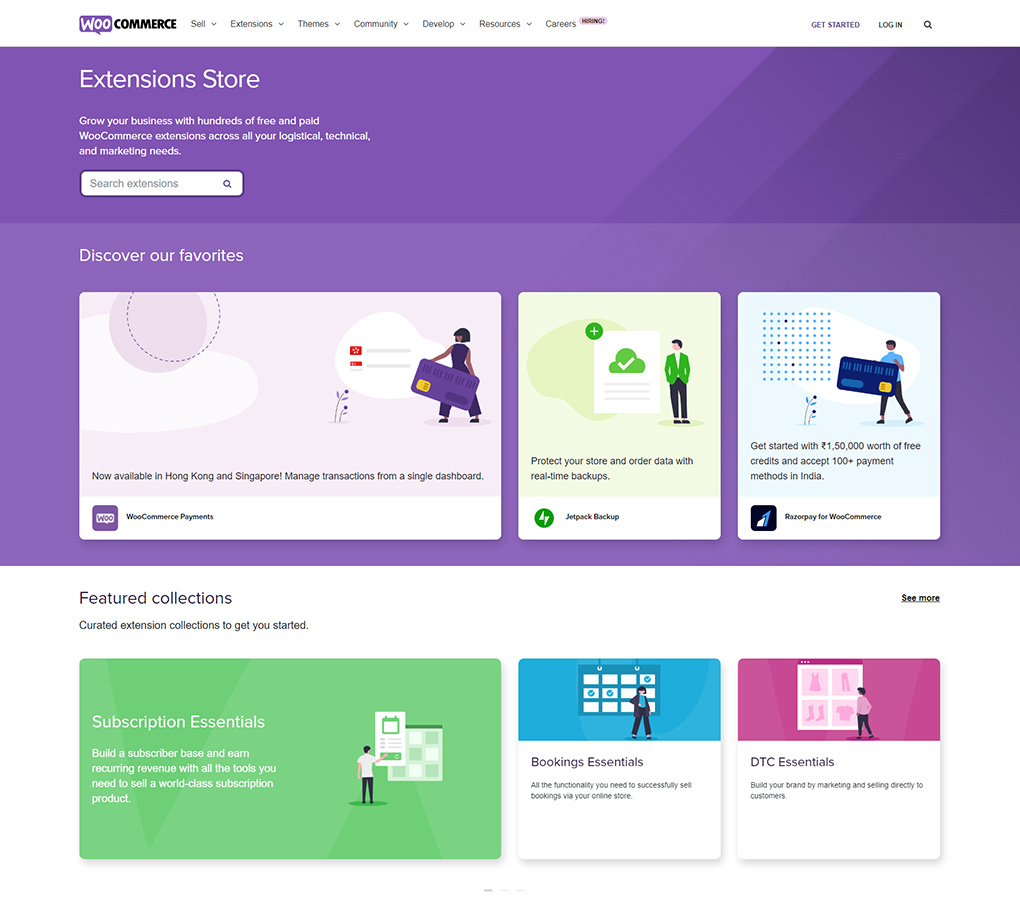
Scalability on Shopify
If you are new to technical terms then Shopify is better. Because it handles the technical part of your store including scalability, performance, and security.

You can select the plan accordingly when your store starts growing. Shopify manages your growing business without any hassle.
Just upgrade your Shopify plan and have no worries. But, when your store grows, your expenses will also grow.
So, plan according to your skills and requirements and choose WooCommerce and Shopify wisely.
Just mark this in mind, for long-term growth WooCommerce is best and for the hassle-free eCommerce solution, Shopify is perfect.
Support Options: WooCommerce vs. Shopify
WooCommerce and Shopify are easy to use. For any further assistance or help for your new store, you can always get support from both platforms.
Let’s check out Shopify and WooCommerce handle support.
WooCommerce Support
As WooCommerce is the world’s leading eCommerce platform, there are dozens of support options available.
You can find in-depth resources including tutorials, documentation, videos, and guides to help yourself.
Also, get support from forums where the WooCommerce support team and expert users guide you.
If you purchase any premium theme from WooCommerce.com, you’re eligible for 24/7 chat support.
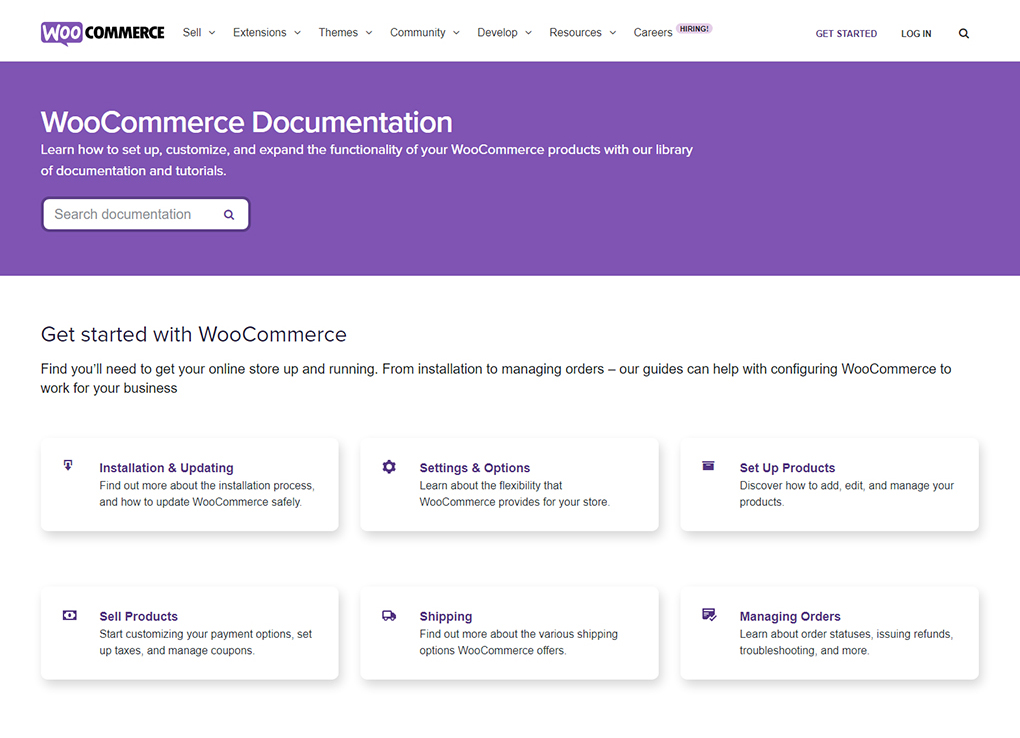
Since WooCommerce is self-hosted, a little self-help is needed. If you are having any issues related to its extensions and plugins, their developers will solve the issues.
Shopify Support
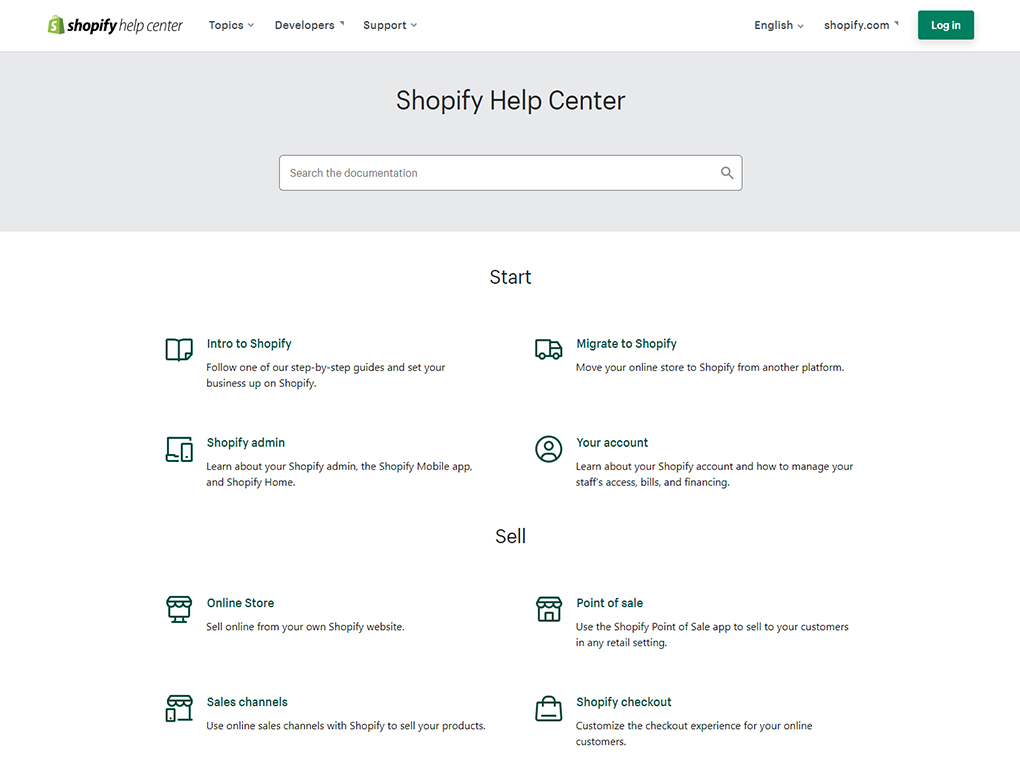
Shopify is a hosted platform and so Shopify developers know their platform best.
It provides 24/7 support through chats, emails, phones, etc. You can also fix things by considering how-to guides, documentation, and videos.
Thus, when it comes to immense customer support, Shopify has a ball in the court. You can easily get support when needed.
Conclusion: Which is better – WooCommerce vs. Shopify?
Both the platforms are powerful. Choosing the better one among WooCommerce and Shopify is truly daunting. The choice depends on your needs and likings.
You can get started with Shopify quickly because you don’t need to install anything. It is easy to use from setting up a payment to different pricing plans.
However, customization is limited with Shopify. You don’t have full control and pricing plans are high including fees and add-ons. The choice is limited with Shopify.
When it comes to WooCommerce, it is an open-source platform. It is flexible and gives full control of customization. The cost of starting an online store with WooCommerce is lower than Shopify.
Have a look at the eCommerce usage distribution below that clearly says WooCommerce is the most used platform.
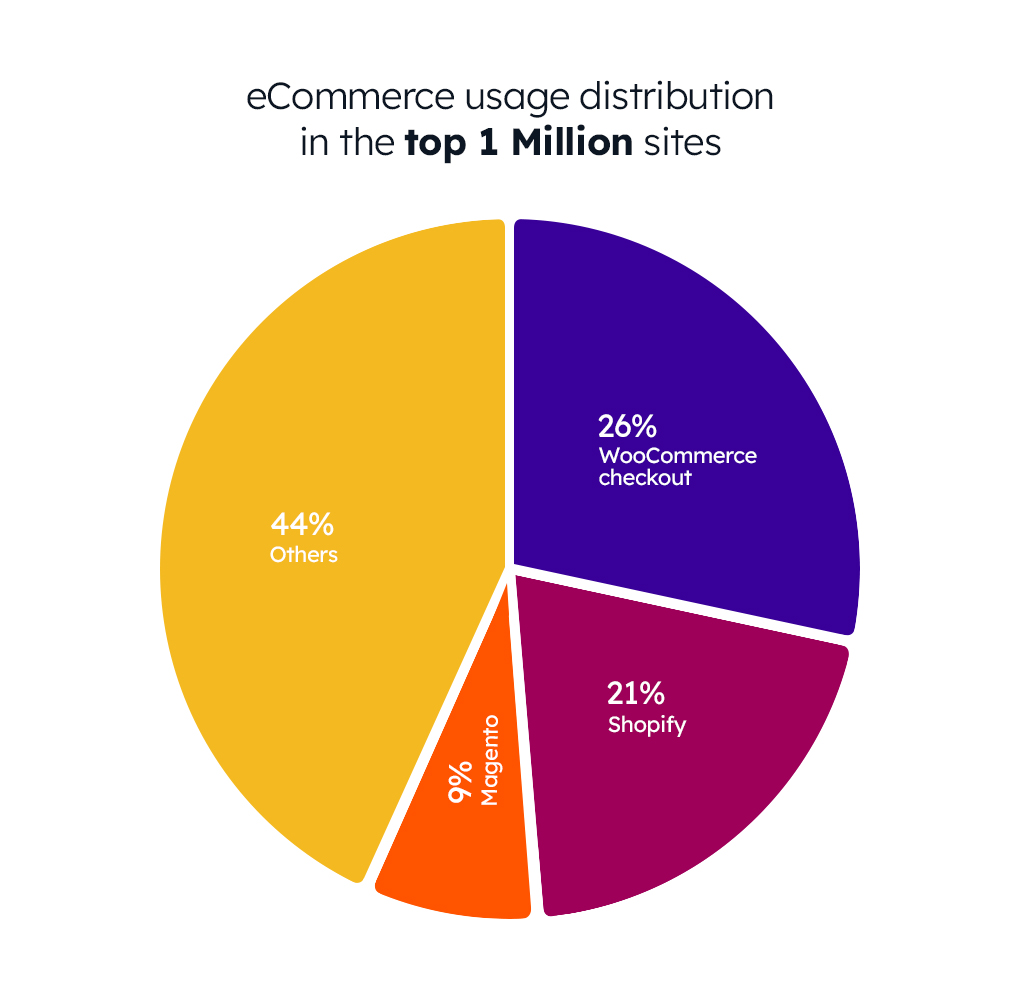
The only drawback is to maintain WooCommerce software and need a bit of WordPress learning. But, you can do that with our detailed guides and theme documentations.
For a cost-effective and long-term solution, choose WooCommerce and customize anything that you want!
Shopify vs. WooCommerce FAQs
Have a look at some of the most frequently asked questions about WooCommerce and Shopify.
1. Difference between WooCommerce & Shopify?
You can easily sell products online using both platforms.
WooCommerce is a WordPress plugin while Shopify is a fully hosted eCommerce platform.
You can manage an online store by yourself with WooCommerce. Just require WordPress hosting and a domain name.
On another side, Shopify provides the software and website hosting to take care of security, maintenance, and backups.
2. Which one is more popular?
WooCommerce is the only answer. It is one of the ultimate eCommerce platforms and is used on top 1 million websites.
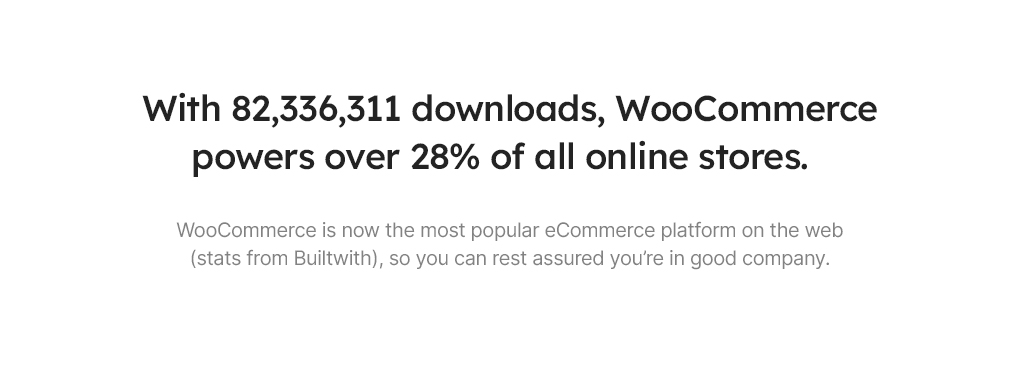
WooCommerce runs on popular WordPress, which itself is powering more than 43% of websites on the internet. And this shows the popularity of WooCommerce.
3. Can I use Shopify on WordPress?
You can use “Shopify Lite” on WordPress. For that just click on Shopify’s Buy Now button and you’re good to go with the complete checkout process.
But, this installation may not deliver the best experience and is a bit tricker for novice users.
4. Are there any alternatives like WooCommerce and Shopify?
WooCommerece and Shopify are two leading eCommerce platforms.
There are many other alternatives like BigCommerce, Magento, PrestaShop, etc. available on the market.
5. Among all eCommerce platforms, which is better?
WooCommerce comes top in the list of flexible eCommerce platforms. As it runs on WordPress, your online store can be used for a business website and blog at the same time.
With its extensions library, WooCommerce is more flexible to customize anything. It also works well with third-party plugins to boost conversions.
Final Thoughts
Both Shopify and WooCommerce have dozens of recommendations and a few drawbacks.
However, to run an eCommerce site seamlessly, we suggest going with WooCommerce. It is the easiest to manage an eCommerce platform built on WordPress.
You can get a significant advantage of WooCommerce and WordPress with a beautiful theme and powerful plugins.
If you find this article informative, please share your feedback here and also follow us on Twitter and Facebook.